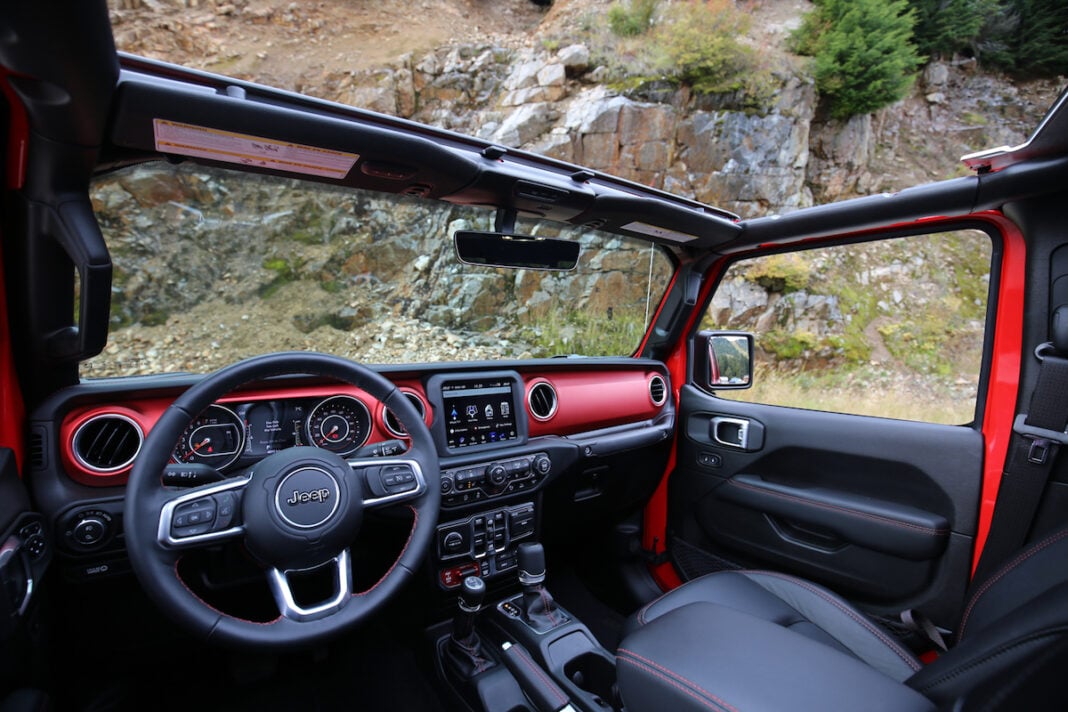This guide is continuously updated for relevance, accuracy, and the most recent information. It was first published in February 2020 and updated and republished in April 2024.
Since arriving in 2020, the 2024 Jeep Gladiator interior has received significant updates to enhance comfort, technology, and safety. The major 2024 interior updates include:
- 12.3-inch Touchscreen Interface: Now standard across all models with Uconnect 5 software.
- Wireless Apple CarPlay and Android Auto: Included in the 12.3-inch system, with navigation optional on higher trims.
- Manual to Power Upgrades: Sport model starts with manual seats, locks, and windows, upgrades available from Sport S trim.
- Mojave X and Rubicon X Trims: Introduce 12-way power, water-resistant seats.
- Jeep Adventure Guides: Access to a database of trails for outdoor adventures.
- Safety Enhancements: Standard first- and second-row side curtain airbags.
- New Wheel Options: A range of 17-inch wheel designs across different trims.
- Open-Air Design Features: Multiple door options, fold-down windshield, and various top configurations.
- Performance Boost: Available Mopar cold air intake system for enhanced horsepower and torque.
- Off-Road Focused X-badged Trims: Mojave X and Rubicon X models feature off-road hardware and luxurious options.
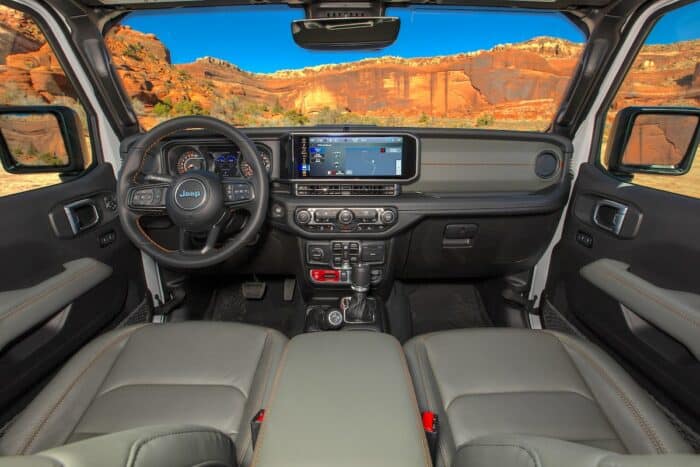
The Gladiator pickup fills a niche in the Jeep model range that has lain dormant since the two-door Comanche pickup ceased production in 1992. Launched in 2019 as a 2020 model, the new mid-size JT Gladiator – reviving a name that was last used on a full-size pickup in 1971 – is based on the critically acclaimed JL Wrangler.
We published a first drive review of the mid-size newcomer last year but for this review we’ll focus on the interior of a 2020 Gladiator Overland that we recently had in for testing.
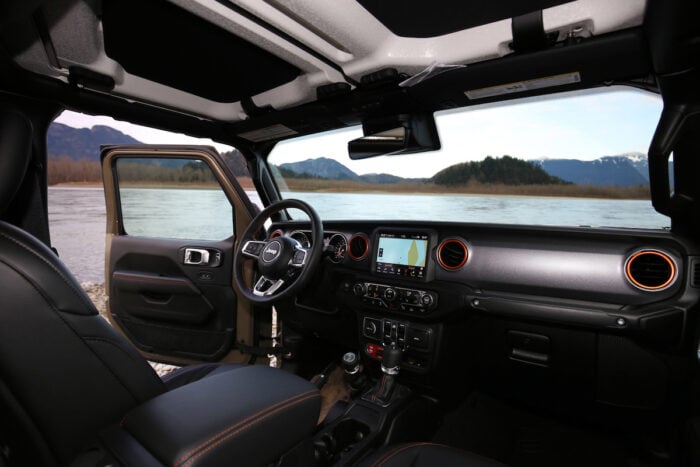
Jeep Gladiator Overland pricing
The 2020 Gladiator lineup currently runs from C$47,545 to C$54,545 in Canada (three models) or US$33,545 to US$43,875 in the US (four models). The Overland trim level is right in the middle and comes with a 3.6-litre V6 gasoline engine (285 HP, 260 lb-ft). There is a stack of available options however and our generously equipped test vehicle came in at a hefty C$64,085 – C$13,000 more than the fully loaded Ranger we drove last year.
The lineup will soon be expanded by the top-of-the-line High Altitude trim with full-leather interior and a ‘Desert Rated’ Mojave model with specific tires and suspension modifications for high-speed sand-running. At the time of writing, prices had not been announced. If you need a more military-spec model for the weekend getaway, check out this Jeep Gladiator XMT Concept by AM General.
Gladiator front seats
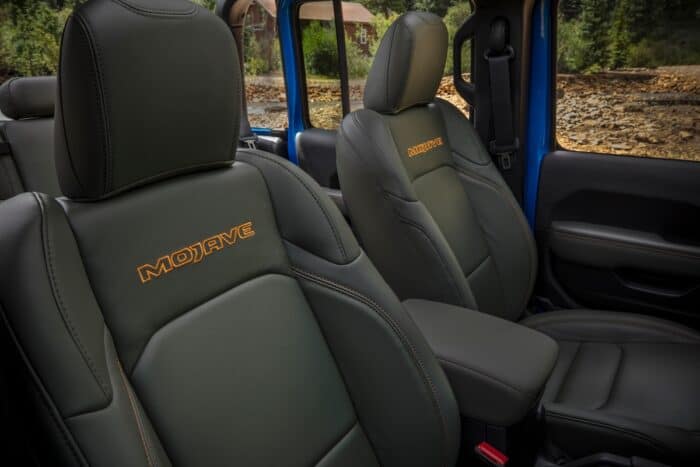
Access to the Gladiator isn’t the easiest – it’s a high step up and the door aperture is relatively short, so you have to watch your head when climbing in. Take care in the rain, too – we got doused by water from the top of the door when we opened it during a heavy shower.
Once sat in your high vantage point however, it’s a commanding view out. Visibility through the flat, sliding rear window is surprisingly good but you have to watch the front corners when parking because the fenders aren’t visible below the tapering line of the hood.
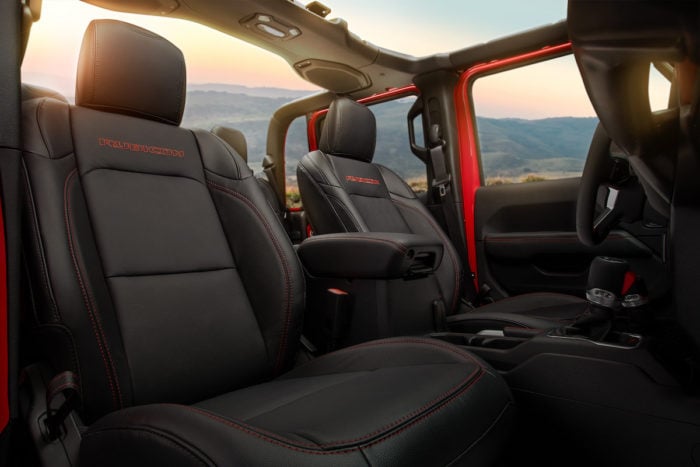
Our test Gladiator came with the optional, black leather-trimmed bucket seats (C$995/US$1,495). The package also includes a full-length floor console with a “premium” armrest, leather-wrapped park brake handle and shift knob, and a wrapped instrument panel bezel. Meanwhile the steering wheel and front seats are heated as part of an optional, C$895 cold-weather package.
The seating position in the front is upright but the seats are comfortable. We’d have preferred to add some steering wheel reach adjustment to the standard adjustment for rake. The controls fall easily to hand and the practical centre console has both a handy slot for your cellphone and a large storage bin beneath the armrest. The latter is useful because the dashboard’s glove box is pretty small.
The door panels have chunky handles at the top that are satisfying to operate and nets at the bottom to keep maps or other items in place. The power window controls are on the dashboard in front of the centre console, presumably because the doors can be removed, Wrangler-style.
Gladiator rear seats

Rear-seat adult passengers don’t get masses of legroom, but they’ll be fine on shorter journeys. Flipping up the rear bench, either altogether or as a 60/40 split – something you can’t do in a Wrangler – enables you to put bulky cargo or the groceries on the floor. The seat backs can also fold down.
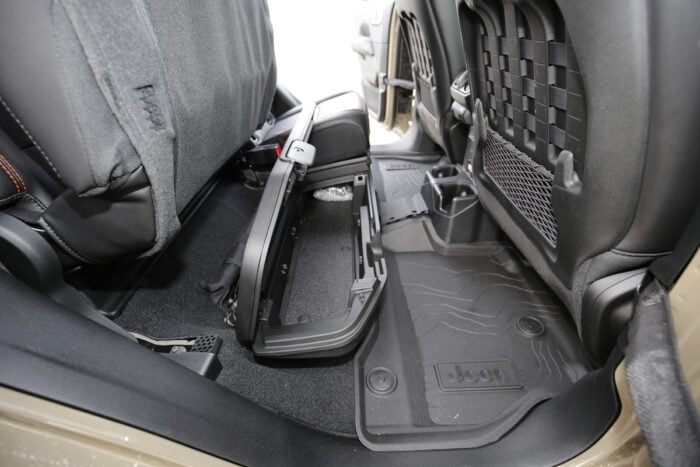
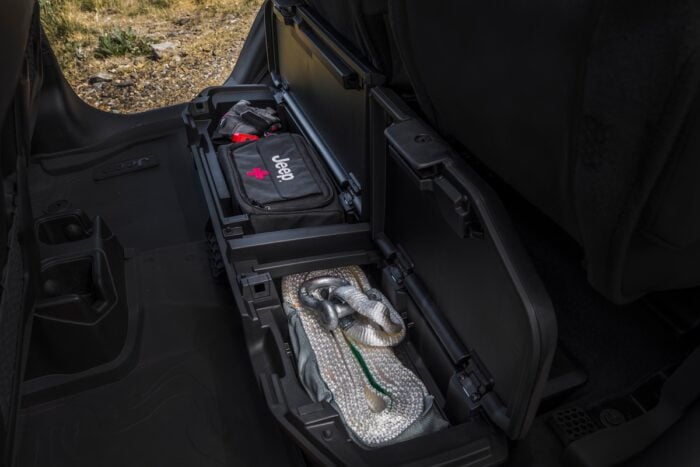
In our test truck, lifting the rear seat revealed a long, thin, lockable and removable storage box. It’s part of the Trail Rail cargo management system (C$995/US$895) that also adds a 240A alternator, 400W inverter and a 115V AC outlet in the truck bed.
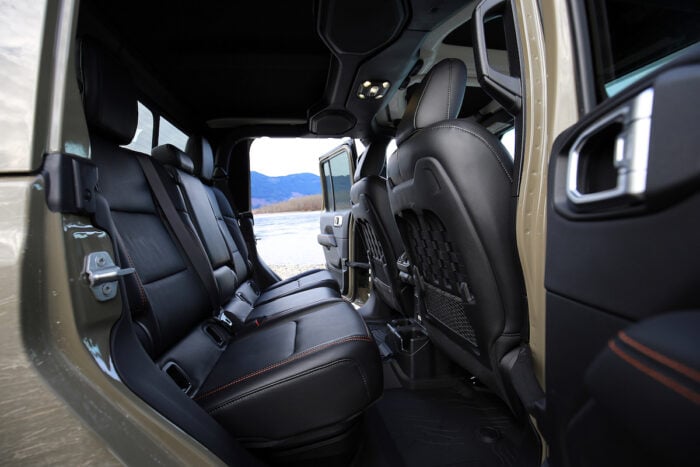
Even without the optional under-seat box, you can store a small amount of gear behind the seat backs and lock them in place to secure it. Also behind the seats is a neat stowage box with holes designed to hold the door bolts, should you choose to remove the doors in weather better than an Albertan winter has to offer!
Dashboard and infotainment
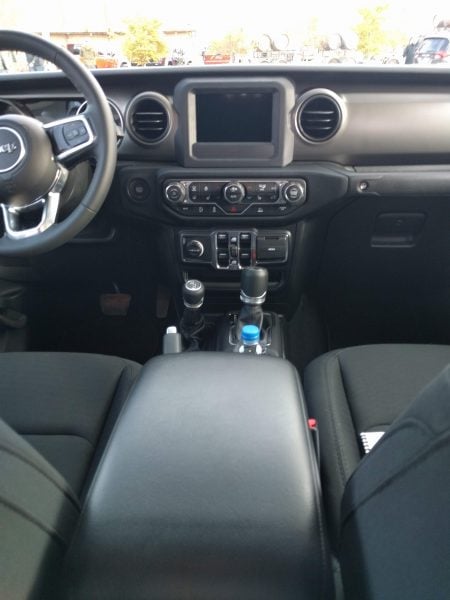
We’ve said it before but it’s worth repeating at this point that the interior designers at FCA, Jeep’s parent company, are on a hot streak right now. The Pacifica, Ram and Wrangler all came with stylish, distinctive, ergonomically impressive interiors that are arguably the best in their respective segments and, in some trim levels, as good as anything the traditional premium brands have to offer.

The Gladiator continues that run of success, not least because most of the interior forward of the B-pillar – the one behind the driver’s head – is common with the Wrangler. That means clean lines, solid build quality and high-mounted, chunky, water-sealed buttons for everything important – in addition to the controls on the 8.4in central touchscreen. The crystal-clear rear-view camera illustrates the quality of the display used here. This larger screen is part of the C$1,395/US$$1,695 Uconnect 4C Nav upgrade that includes a premium Alpine audio system.
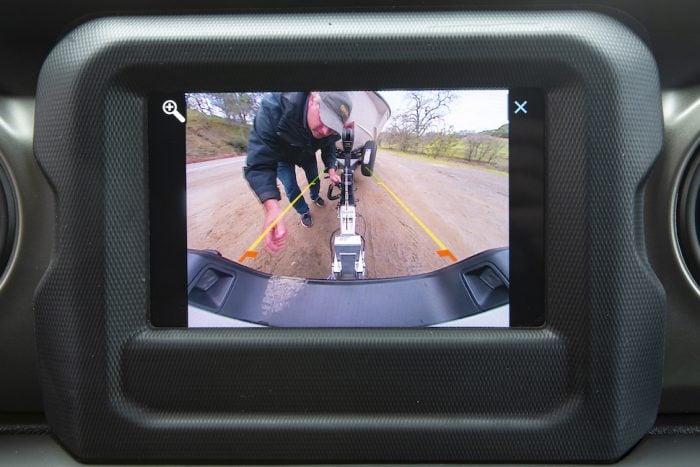
The Overland’s screen accesses the Uconnect 4 infotainment system, which is easy to operate. Lower grades get a smaller screen and the simpler Uconnect 3. FCA has just unveiled Uconnect 5 in the 2020 Pacifica, but it’s not in a Jeep yet.
There’s also a digital screen in the driver’s instrument binnacle. The miniature Gladiator that drives across it at startup is a nice touch.
Other Jeep Gladiator Interior Tech and Features
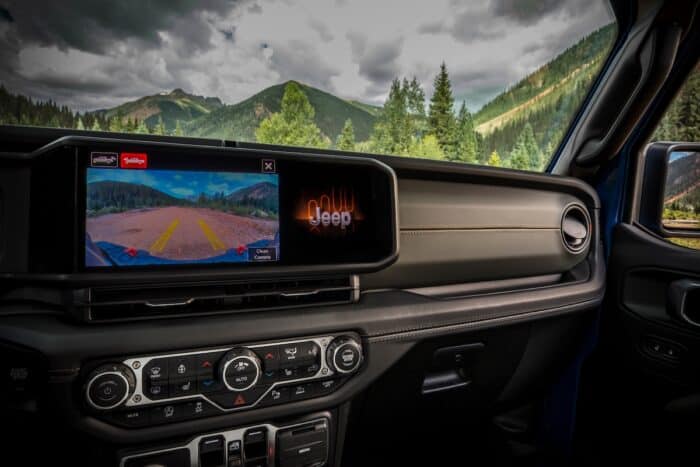
This isn’t a full road test, but our week with the Gladiator Overland did give us an idea of how it would be to live with the Jeep every day. The first thing to say is that the standard Bridgestone Dueler H/T all-season tires are wholly inadequate in a Canadian winter. You should absolutely put it on proper winter tires in these conditions. Even in good weather, it’s hard to see how the low-rolling-resistance Duelers would be appropriate for the sort of ‘Overland’, go-anywhere use for which Jeep designs its vehicles. In Canada they can be switched at purchase for A/Ts for an additional C$295.
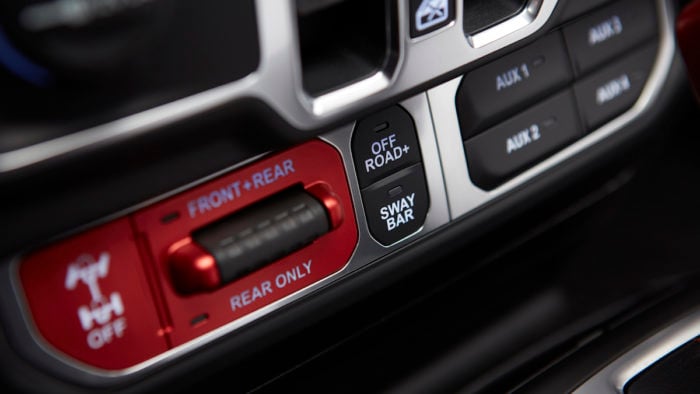
Second, the Gladiator isn’t the most relaxing ride on the highway. Both of the trucks we’ve driven wandered around badly at speed, leaving you to continuously work the steering wheel, B.A. Baracus-style, to keep the truck straight.
We also had a lot of wind noise from the roof, despite the C$725/US$555 hardtop headliner. It’s an issue that arose during the first drive too; if it’s a case of poor sealing then we might add the doors to that list, which leaked when we took a Gladiator off-road during evaluation for AJAC Canadian Car of the Year (but it ate up the challenging course, as you’d expect). The Jeep, incidentally, is the reigning North American Car of the Year.
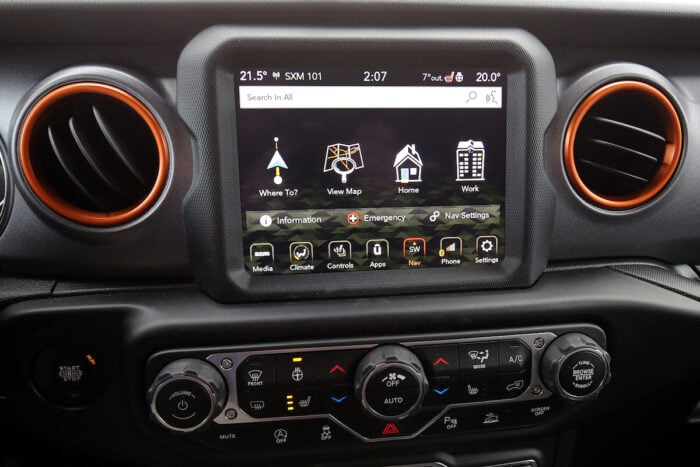
The V6 provides sufficient power and torque for everyday use. It was mated here with an 8-speed automatic transmission – another optional extra (C$1,795/US$2,000), because all Gladiators come as standard with a 6-speed manual. The stop-start system works well in traffic and the truck started quickly after a couple of days sat out in freezing temperatures. We recorded 12.7L/100km in mixed use, which is only a tick above the official number. A 3-litre EcoDiesel option is coming soon and could prove to be a terrific match for the Gladiator.
Takeaway
Pros:
- Attractive, functional design
- Easy and satisfying to operate
- Rear-seat folding and storage flexibility
Cons:
- No steering wheel reach adjustment
- Cost-options quickly add up
- Questionable wind and water sealing
The Gladiator is a unique take on the mid-size truck segment, offering a rugged, off-road-focused alternative to mainstream pickups like the Toyota Tacoma, Chevrolet Colorado or Ford Ranger. It’s already selling strongly, and aftermarket companies have been quick to embrace it with all manner of available accessories and upgrades.

Even in factory trim however, the interior is a highlight, as it is in so many recent FCA products. It’s great to look at and the controls are easy and satisfyingly weighty to operate. The rear-seat folding options add practicality, too.
But with so many desirable features available as optional extras, the final bill can quickly escalate. We’d recommend taking a good look at the standard equipment levels – and thinking carefully about which additional items you’d consider essential – before making a final choice.

